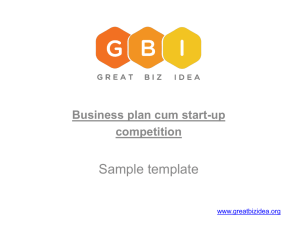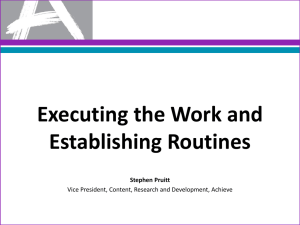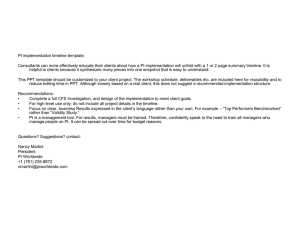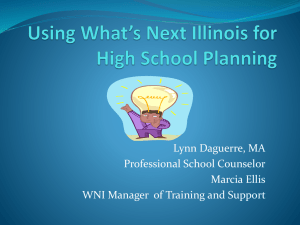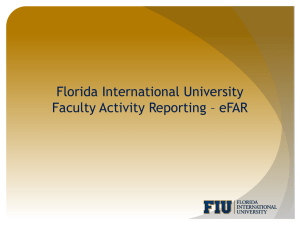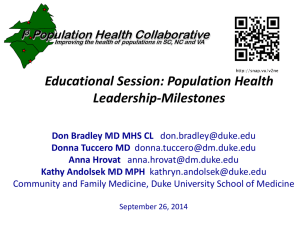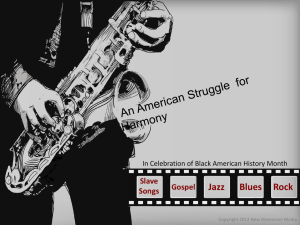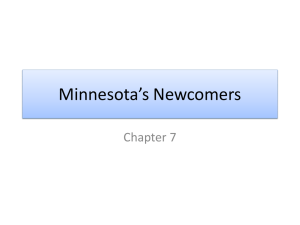Creating and Implementing an Online Orientation from the Ground Up
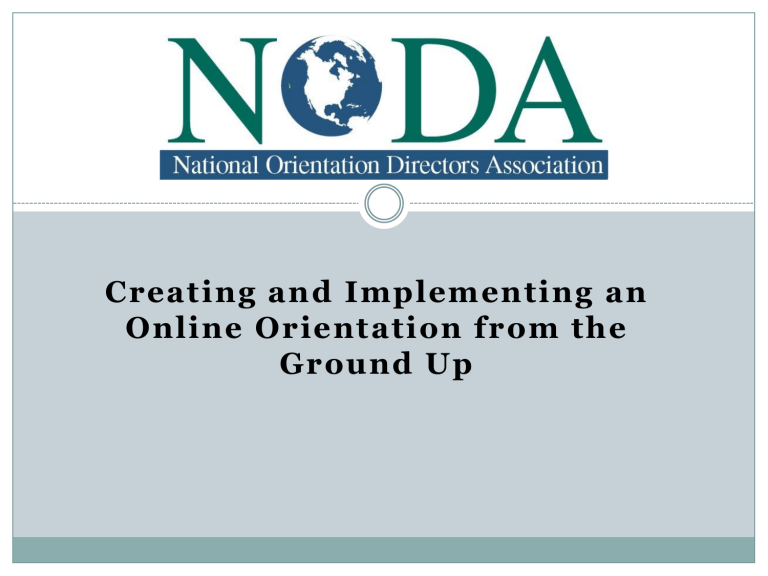
Creating and Implementing an
Online Orientation from the
Ground Up
Clay Adams
Assistant Dean for New Student Programs
Duke University clay.adams@duke.edu
Katie Granholm
Assistant Director of Orientation and the Transfer Experience
University of Minnesota, Twin Cities granh013@umn.edu
Jessica Hale, Ed.D
Professional Services Faculty
Washtenaw Community College jhale15@wccnet.edu
Creating and Implementing an Online Orientation from the Ground Up – December 10, 2010
Mission:
The mission of the National Orientation Directors
Association is to provide education, leadership and professional development in the fields of college student orientation, transition and retention
Core Values:
Community, Diversity, Integrity, Learning, Scholarship,
Service.
Creating and Implementing an Online Orientation from the Ground Up – December 10, 2010
NODA Home Office
University of Minnesota
1313 Fifth Street SE
Suite 323A
Minneapolis, MN 55414
Toll free: 866-521-NODA or 612-627-0150
612-627-0153 (fax) noda@umn.edu
www.nodaweb.org
Creating and Implementing an Online Orientation from the Ground Up – December 10, 2010
Learning Outcomes
Engage in discussion of the key components of online orientation creation.
Interact with orientation professionals who have experience with successful online orientation programs.
Create a plan for implementing your own online orientation.
Creating and Implementing an Online Orientation from the Ground Up – December 10, 2010
Introduction and Background
The goal of orientation is to help students integrate socially and academically into college environment
(Tinto, 1975)
Over the last few decades orientation programs have experienced rapid growth and evolved to meet the changing needs of students
(Strumpf, Sharer, & Wawrzynski, 2003)
Online education is growing at a rate that far outpaces faceto-face higher education
(Allen & Seaman, 2009)
Online orientations are emerging as an acceptable means to facilitate the transition process
Creating and Implementing an Online Orientation from the Ground Up – December 10, 2010
Online Orientation : A web-based orientation program that occurs synchronously or asynchronously
Creating and Implementing an Online Orientation from the Ground Up – December 10, 2010
Current Online Orientation Practices
Online Orientation programs are utilized at all types of institutions
Used for many different student populations
Utilize various platforms
Synchronous
Asynchronous
Three Primary Types of Online Orientation Programs (Page, 2009)
Pre-Orientation
Replacement
Hybrid
Creating and Implementing an Online Orientation from the Ground Up – December 10, 2010
Relevant theories:
• Participatory Learning
(Shirky, 2008)
• Active Learning
(Astin, 1999)
• Web 2.0
(Yuen, 2010)
• Concept of Cognitive Surplus
(Shirky, 2010)
Take Home Point:
• Learning is an interactive and participatory process facilitated by media
Creating and Implementing an Online Orientation from the Ground Up – December 10, 2010
Overview of the Planning Process
1.
2.
3.
4.
5.
6.
7.
Set Goals
Identify Key Players and Collaborators
Evaluate Resources
Explore the Technology
Develop a Process and Timeline
Create an Assessment Plan
Maintain and Revise
Creating and Implementing an Online Orientation from the Ground Up – December 10, 2010
Set Goals
What is the purpose of your online orientation?
What population(s) will the online orientation serve?
How will the online orientation relate to existing programs?
How will you make your online orientation participatory and interactive?
What are your learning outcomes?
Creating and Implementing an Online Orientation from the Ground Up – December 10, 2010
Goal Setting at Duke
Action Item Response
What is the purpose of your online orientation?
What population(s) will the online orientation serve?
How will the online orientation relate to existing programs?
How will you make your online orientation participatory and interactive?
• Assist in the overall transition of our students through added, intentionally designed, touch points
• Primary – Undergraduate, traditional, firstyear students
• Secondary - International students
(undergraduate, graduate and professional)
• Tertiary – Parents, guardians, family members
• Amplify or enhance the messages currently being shared
• Supplemental
• Q/A
• Polls
• Documents sharing
Creating and Implementing an Online Orientation from the Ground Up – December 10, 2010
Set Goals: Learning Outcomes
Duke
Overarching Learning Outcomes
(Synchronous programs)
• Students will learn to proactively participate in their education process
(through collaboration with university officials and peers)
Nine Modules – Separate Learning
Outcomes for each session
Example – Academic Advising Module
• Understand the First Year academic requirements
UMN-TC
Overarching Learning Outcomes
(Asynchronous Program)
• Understand the academic and community expectations of a University of Minnesota student.
• Become acquainted with the resources available to University of Minnesota students.
• Have a better understanding of the University of Minnesota student experience.
• Be prepared to take responsibility while enrolled at the University of Minnesota.
• Develop an overall working knowledge of our online scheduling system
• Feel more prepared to transition into the
University.
Creating and Implementing an Online Orientation from the Ground Up – December 10, 2010
What are your desired learning outcomes?
Creating and Implementing an Online Orientation from the Ground Up – December 10, 2010
Identify Key Players and Collaborations
Who needs to involved to make an effective online orientation a reality?
Internal
Your office
College constituents
Departmental partners
Web Services/Information Technology
External
New students
Parents and supporters
Sponsors
Other
Creating and Implementing an Online Orientation from the Ground Up – December 10, 2010
Key Players and Collaborations at WCC
Internal
Your office
College constituents
Departmental partners
Web Services/Information
Technology
Key Players and Collaborators
• New Student Orientation
• President
• Dean of Support Services and Student Advocacy
• Counselors/Advisors
• Students
• Admissions
• Enrollment Services
• Public Relations and Marketing
• Director
• Wed Designers
• Programmers
• Videographers
Creating and Implementing an Online Orientation from the Ground Up – December 10, 2010
Who might fall into the “other” group of key collaborators?
Creating and Implementing an Online Orientation from the Ground Up – December 10, 2010
Evaluate Resources
What resources are available?
Immediate vs. long-term
Internal vs. external
What is your budget?
Start-up costs
Maintenance costs
What human resources are needed?
Editing, graphic design, web design, programmer, etc.
Creating and Implementing an Online Orientation from the Ground Up – December 10, 2010
Resources at UMN-TC
Action Item
What resources are available?
Response
• Transfer student confirmation fee: $80
• No additional funding; Need to work within existing budget for initial start-up
• Long-term: Account for needs in each 3-year budget cycle
• External funding: Instructional Technology Grant of $10,000
What is your budget?
What human resources are needed?
• No additional financial resources
• Utilize existing staffing and technology resources
• Internal: graphic design (limited), orientation professional for content development and editing
• External: WebCT/WebVista central support/troubleshooting, Instructional Technology support, content experts
Creating and Implementing an Online Orientation from the Ground Up – December 10, 2010
What is your budget for online orientation?
Creating and Implementing an Online Orientation from the Ground Up – December 10, 2010
Explore the Technology
What capabilities do you require based on your goals?
Customization
Participation tracking
Interactive components like videos, quizzes, etc.
What type of platform will you use?
Synchronous vs. Asynchronous
What products/tech support is available through your institution?
In-house vs. third party vendor
Creating and Implementing an Online Orientation from the Ground Up – December 10, 2010
Technology Exploration at WCC
Action Item
What capabilities do you require based on your goals?
Response
• Customization with Banner
• Tracking of participation
• Interactive components like videos, quizzes, etc.
What type of platform will you use? • Asynchronous
What products/tech support is available through your institution?
• In-house design
• In-house server
• Web Services/Information Services
Creating and Implementing an Online Orientation from the Ground Up – December 10, 2010
What type of platform would you like to use?
Creating and Implementing an Online Orientation from the Ground Up – December 10, 2010
Develop a Process and Timeline
How will content be developed and edited?
Content driven by your learning outcomes
Individual vs. collective process
Is special expertise needed?
Graphic design, web design, database building
If so, what does this timeline look like?
When will online orientation be available?
Allow time for usability testing, editing, demonstration, etc.
Creating and Implementing an Online Orientation from the Ground Up – December 10, 2010
Process and Timeline at Duke
Action Item
How will content be developed and edited?
Is special expertise needed?
When will online orientation be available?
Response
Content is a shared responsibility in our platform as it combines both the university
“expert” and the student participants
Technology – no!
Content – yes, and this is why….
May-August to coincide with action-item due dates
Creating and Implementing an Online Orientation from the Ground Up – December 10, 2010
Sample Timeline
Action Item
Outline current challenges/opportunities in current work
Define goals and constraints
Approach key players
Timeline
Working knowledge – tangibly defined in
November/December
See above
Mid-December, February, April & May
Explore technologies
Content development
Training & Pilot
Evaluate & revise
Implement
Mid-December – Late January (asked for
6 weeks) – followed up in 2
March & April
May & June
July & September
Following summer
Creating and Implementing an Online Orientation from the Ground Up – December 10, 2010
What is your timeframe from conception to implementation?
Creating and Implementing an Online Orientation from the Ground Up – December 10, 2010
Create an Assessment Plan
What determines success?
Accomplishment of learning outcomes, participation rate, etc.
How will success be measured?
When will success be measured?
What do you need to know?
May be driven by stakeholders/campus constituencies
What methods of evaluation will you use?
Online questionnaire, paper form, follow-up survey, focus groups, usability testing, etc.
Does the evaluation method align with desired outcomes?
Creating and Implementing an Online Orientation from the Ground Up – December 10, 2010
Assessment Plan at WCC
Action Item Response
What determines success?
How will success be measured?
• 100% mastery of quizzes
• 95% completion rate
• Statistics from the online orientation
• Clicker results from in-person orientation
• Focus groups
• Qualitative feedback provided in in-person orientation
When will success be measured? • Immediate feedback for each student
• Beginning of each in-person orientation
• Annual review and update process
What do you need to know?
What methods of evaluation will you use?
• Success rate
• Completion rate
• Attempts per question
• Percentage correct at beginning of in-person orientation
• Multiple choice
• True/False
• Sequencing
• Likert scale
• Open-ended evaluation
Creating and Implementing an Online Orientation from the Ground Up – December 10, 2010
How will you define success?
Creating and Implementing an Online Orientation from the Ground Up – December 10, 2010
Maintain and Revise
• How will content be maintained? o What is involved in this process? o What is the timeline? o Who is responsible?
• How will technology be maintained? o What is the process? o What is the timeline? o Who is responsible?
• How often will major revisions take place?
Creating and Implementing an Online Orientation from the Ground Up – December 10, 2010
Maintenance and Revision at UMN-TC
Action Item Response
Who will maintain the content? • Each department asked to review content each orientation cycle. Orientation staff member provides guidance, edits and compiles the content.
• Content updates/revisions obtained 3-4 weeks prior to launch
Who will maintain the technology? • Course management system maintained by Office of Information Technology
• Online orientation course maintained by in-house technology specialist
How often will major revisions take place?
• Plan for major changes and revisions every 2 years
Creating and Implementing an Online Orientation from the Ground Up – December 10, 2010
What challenges do you foresee in maintaining your online orientation?
Creating and Implementing an Online Orientation from the Ground Up – December 10, 2010
Tips for Success
Set clear goals
Identify key players and collaborators early
Evaluate resources
Explore technological options
Create an assessment plan during product development
Plan a staged implementation
Build an exaggerated timeline
Creating and Implementing an Online Orientation from the Ground Up – December 10, 2010
Learning Outcomes Revisited
Engaged in discussion of the key components of online orientation creation.
Interacted with orientation professionals who have experience with successful online orientation programs.
Created a plan for implementing your own online orientation.
Creating and Implementing an Online Orientation from the Ground Up – December 10, 2010
References
Allen, I.E., & Seaman, J. (2009). Learning on demand: Online education in the United States, 2009. Needham, MA:
Sloan-C. Retrieved from http://www.sloan-c.org/resources/survey04a.asp
Astin, A. W. (1999). Student involvement: A developmental theory for higher education. Journal of College Student
Development, 40(5), 518-529.
Page, D. (2009). Online orientation program research summary. Minneapolis, MN: National Orientation Directors
Association.
Shirky, C. (2008) . Here comes everybody: The power of organisation without organisations . London: Allen Lane.
Shirky, C. (2010). In Tantor Media. (Ed.), Cognitive surplus [sound recording]. Old Saybrook, Conn. : Tantor Media.
Strumpf, G., Wawrzynski, M., & Sharer, G. (2003). 20 years of trends and issues in orientation programs. In (Eds).
Designing successful transitions: A guide for orienting students to college. The Freshman Year Experience Monograph
Series. South Carolina University, Columbia. National Resource Center for the Freshman Year Experience. National
Orientation Directors Association.
Tinto, V. (1975). Dropout from higher education: A theoretical synthesis of recent research. Review of
Educational Research, 45(1), 89–125.
Yuen, S.C. (2010). Collective intelligence and e-learning 2.0 : Implications of web-based communities and networking .
In Yuen S. C. (Ed.), Hershey, PA : Information Science Reference.
Creating and Implementing an Online Orientation from the Ground Up – December 10, 2010


